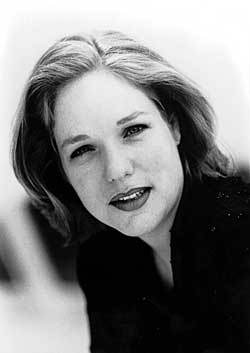S & H Concert Review
Prokofiev, Tüür, Shostakovich, City of Birmingham Symphony Orchestra, Isabelle van Keulen (violin), Paavo Järvi, Symphony Hall, Birmingham, 28th May 2002 (CT)
Sergei Prokofiev The Love of Three Oranges Ė Suite
Erkki-Sven Tüür Violin Concerto ē Aditus
Dmitri Shostakovitch Symphony No. 9 in E flat Op. 70
Paavo Järviís former spell as Principal Guest Conductor of the City Of Birmingham Symphony Orchestra was obviously not lost on this audience for, although modest in numbers, there was clearly a very audible enthusiasm for both Järvi himself and the music. And rightly so, for from the opening bars of the Prokofiev it was clear that the dapper young Estonian conductor (not for the first time I was reminded of his striking facial resemblance to his father Neeme) was stamping his authority on the music in a very positive manner, conducting with determination, admirable technical clarity and a confidence that at once communicated itself with both players and audience. Järvi obviously knew what he wanted to achieve from this music and it made for a rewarding concert experience.In the Prokofiev this meant a performance of appropriate swagger, at times arrogance but above all stylistic character. If the opening of Les Ridicules (strange that the programme notes failed to give listeners the titles of the movements) just lacked a little rhythmic drive in the opening bars it more than made up for it in the delightfully playful flute dominated scherzando section shortly before the conclusion, the final bars showing fine bombast. The Scène Infernal was packed with mystery and magic, magnificent strings here, and the famous March benefited from finely chosen tempos that allowed the musicís pomposity to come through admirably. For my taste I found the Scherzo just slightly heavy handed but once again the strings shone through in the evocative opening of Le Prince et la Princess with beautifully sensitive and atmospheric playing. The furiously headlong pace of La Fuite managed to maintain fine instrumental clarity whilst not skimping on excitement.
This was the UK premiere of Tüürís Violin Concerto, written in 1999 for Isabelle van Keulen (left), and it was a delight that the composer had made the journey to Birmingham for the performance despite what must have been his searing disappointment at missing the Eurovision Song Contest in his home city of Tallinn on the previous Saturday. This was my first experience of Isabelle van Keulen live and the physical commitment of her performance here was, at times, both fascinating and for her I am sure, very tiring. Cast in three movements played continuously, the work is largely about tension, both in terms of the relationship between the soloist and orchestra, but also in the constant effort to handle the relentless struggle between atonality and tonality, serialism and modality. The result is kaleidoscopic in the extreme; music capable of generating an extraordinary sense of cumulative energy and which in the case of the long first movement in particular, rarely pauses for breath. The rapidly bowed arpeggios with which the soloist opens (a hint of John Adams here perhaps) set the incessant scene and return elsewhere in the work as a landmark from time to time. Melodies and figures frequently fly between soloist and orchestra, the result never short of exhilarating. In complete contrast the sudden arrival of the slow movement freezes the music in its steps, a long series of slow glissando and drone effects emanating from the strings before the soloist initiates a more lyrical aspect. The final breathless movement has a folk like feel about it, albeit again with quasi-minimalist undertones. I can only say that Isabelle van Keulen excelled herself and it was good to hear the deserved appreciation shown by the audience for the performance and also the appearance of the composer. In the circumstances, Tüürís Aditus, with whichthe second half began, seemed like an encore piece although it is actually intended as a pyrotechnical concert opener, as the Latin title implies. Occasional thoughts of Lutoslawski and perhaps Magnus Lindberg here in a stunningly brilliant, highly virtuosic showpiece constructed around the chromatic scale. Imaginatively written with a fine ear for unusual orchestral sonority, the orchestra very clearly enjoyed themselves here despite the technical challenges of the music, not least in the hard worked percussion section who employed as large a selection of instruments as I have seen for some while!
Any other Shostakovitch symphony, with the possible exception of the first, would have felt oddly out of place after the Tüür, but the tongue in cheek spirits of No. 9 were, on this occasion, the perfect palette cleanser after the sheer physicality of the Estonian work before it. In fact it did take the orchestra a few minutes to settle into it, the first movement not short of fine playing but not quite inside the music, whereas the ensuing Moderato was far more characterful and marked by beautifully articulated clarinets at the outset and strings of perfect weight and poise. The Presto (magnificent trumpet solo here!) had a far greater sense of drive than the opening Allegro and the "wall of sound" from the brass in the Largo come across with admirable power. Järvi relished every moment of the final Allegretto, orchestra and conductor wrapping up the evening with a real flourish. It is to be hoped that Paarvo Järvi will continue to be a regular visitor to Birmingham, a point to which the reaction of the audience would seem to lend unanimous support.
Christopher Thomas


 Return
to:
Return
to: